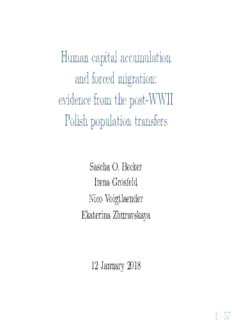
Human capital accumulation and forced migration PDF
Preview Human capital accumulation and forced migration
Human capital accumulation and forced migration: evidence from the post-WWII Polish population transfers Sascha O. Becker Irena Grosfeld Nico Voigtlaender Ekaterina Zhuravskaya 12 January 2018 1/ 57 Intro Data Results Mechanism Conclusions Motivation Experiment Question Literature Motivation Economists and historians have hypothesized that • minorities who face expulsions tend to invest more in mobile assets such as human capital. Brenner and Kiefer (1981): “...a discriminated-against • group which has had physical capital confiscated in the past might tend to take the probability of confiscation of an asset into consideration when making an investment. Further, a group which had been compelled to emigrate from a country might take the portability of an asset into consideration when making an investment in a new country, especially if it continues to face discriminations”. 2/57 Becker,Grosfeld,Voigtlaender,Zhuravskaya Humancapitalandforcedmigration Intro Data Results Mechanism Conclusions Motivation Experiment Question Literature Motivation For Jews, this explanation has been challenged by Botticini • and Eckstein (2012) as there are other important reasons for high education among Jews In addition, the argument about the relationship between • expulsions and human capital accumulation has generally been made for groups that continue facing discrimination However, often discrimination implies direct restrictions on • accumulation of physical capital 3/57 Becker,Grosfeld,Voigtlaender,Zhuravskaya Humancapitalandforcedmigration Intro Data Results Mechanism Conclusions Motivation Experiment Question Literature In this paper Use historical episode of one-time expulsion of a group that • was not discriminated against in the destination location to test whether forced migration permanently affects decisions to invest in human capital This episode allows us to isolate the effect of the • forced migration per se from the effect of the labor market conditions at the destination, as we are able to compare human capital accumulation of forced and non-forced migrants within the same labor market We also show that the results cannot be driven by selection • in either treatment or control group 4/57 Becker,Grosfeld,Voigtlaender,Zhuravskaya Humancapitalandforcedmigration Intro Data Results Mechanism Conclusions Motivation Experiment Question Literature Natural experiment: After WWII, Poland gained territories East of Oder-Neisse, called Western Territories • lost territories East of Curzon line, called Kresy (Eastern • Borderlands) 5/57 Becker,Grosfeld,Voigtlaender,Zhuravskaya Humancapitalandforcedmigration Intro Data Results Mechanism Conclusions Motivation Experiment Question Literature Natural experiment The change of borders triggered mass population movements: WT were populated by 3.5m Germans and 1m Poles in 1945 • Before WWII, 8.5m Germans, 1m Poles, 100,000 Jews lived in WT • 1945-1949: Poles were expelled from Kresy and moved to WT • Germans were expelled from WT and resettled in Germany • Voluntary migrants from Central Poland moved to WT to • benefit from housing, land, and infrastructure left by Germans 96% of WT’s total 5.6m population in 1950 were Poles, i.e., • Roman Catholics and Polish native speakers The rest were Jews (380,000 Polish Jews survived WWII), • who subsequently left, and Ukrainians, who were forced migrants from CP (“Operation Vistula”) 6/57 Becker,Grosfeld,Voigtlaender,Zhuravskaya Humancapitalandforcedmigration Intro Data Results Mechanism Conclusions Motivation Experiment Question Literature According to 1950 census, 1000s of people WesternTerritories(WT) CentralPoland(CP) ShareinWT Totalpopulation,1950 5,602 19,012 22.8% LivedinCPin1939 2,785 18,355 13.2% (49.7%) (96.5%) LivedinUSSRin1939 1,554 583 72.7% (27.7%) (3.1%) LivedinWTin1939 1,112 19 98.3% (19.9%) (0.1%) Livedabroad(notUSSR)in1939 152 53 74.0% (2.7%) (0.3%) 7/57 Becker,Grosfeld,Voigtlaender,Zhuravskaya Humancapitalandforcedmigration Intro Data Results Mechanism Conclusions Motivation Experiment Question Literature Kresy migrants were put on the train and brought to WT 8/57 Becker,Grosfeld,Voigtlaender,Zhuravskaya Humancapitalandforcedmigration Intro Data Results Mechanism Conclusions Motivation Experiment Question Literature Kresy migrants were put on the train and brought to WT 9/57 Becker,Grosfeld,Voigtlaender,Zhuravskaya Humancapitalandforcedmigration Intro Data Results Mechanism Conclusions Motivation Experiment Question Literature Migrants from CP were invited to come and explore available resources: “ The land is waiting” 10/57 Becker,Grosfeld,Voigtlaender,Zhuravskaya Humancapitalandforcedmigration
Description: